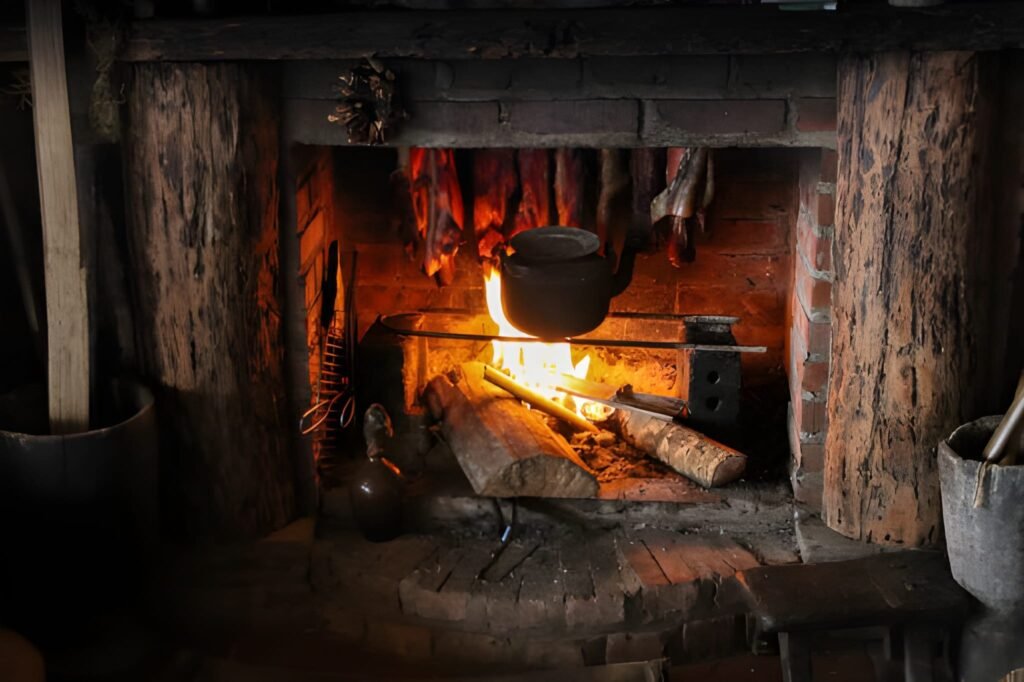Cooking Without Pots: A Story of Ingenuity
Imagine sitting by a fire thousands of years ago. There’s no metal pot, no ceramic dish, just a skin bag filled with water and wild roots. Someone carefully drops heated stones into the bag, and soon, steam rises. The water bubbles, the roots soften, and within minutes, dinner is ready. This is stone-boiling ancient cooking, one of the most ingenious survival methods ever invented.
Long before iron cookware, people around the world discovered that fire-heated rocks could be used to cook stews, soups, and even brew drinks. The method may seem primitive, but it reveals incredible adaptability and it shows just how creative humans have always been when faced with a problem: how to turn raw ingredients into nourishing meals.
Why Stone Boiling Ancient Cooking Matters
Stone boiling wasn’t just a quirky technique. It mattered because it allowed people to:
-
Boil food in containers that couldn’t survive direct flames, like bark baskets, wooden troughs, or animal hides.
-
Extract nutrients from tough roots, grains, and bones.
-
Sterilize water, which was crucial for survival.
-
Cook in portable, makeshift “pots” during travel or hunting.
For archaeologists, stone boiling provides insight into early societies’ resourcefulness. For modern readers, it’s a reminder that good cooking doesn’t always need fancy tools; sometimes, it just needs fire, water, and rocks.
How Stone Boiling Worked
1. Heating the Rocks
Flat or rounded stones were placed directly into a fire until they glowed hot. People avoided porous rocks, which could explode from trapped moisture.
2. Preparing the Container
Instead of pots, people used wooden bowls, bark baskets, clay-lined pits, or animal-skin bags filled with water. These couldn’t withstand flames but could hold hot water.
3. Dropping the Stones
Using sticks or tongs made from bone or wood, cooks transferred the glowing stones into the container of water. The sizzling sound of stone meeting water must have felt like magic.
4. Maintaining Heat
As the water cooled, more hot stones were added until the food was fully cooked. This allowed stews, soups, and porridges to simmer, even without durable cookware.
5. Serving the Meal
Once cooked, food could be eaten directly from the container. Sometimes, herbs or grasses were added for flavor—a primitive form of seasoning.
Table: Comparing Ancient Cooking Methods
| Method | Tools Used | Advantages | Limitations |
|---|---|---|---|
| Stone Boiling | Rocks, hide bags, baskets | Allowed boiling without pottery | Needed constant fire & rocks |
| Fire Roasting | Open flame, sticks | Simple, direct cooking | Risk of burning, limited foods |
| Earth Ovens | Pits, hot stones, soil | Could cook large meals slowly | Time-consuming |
| Clay Pot Cooking | Clay vessels, fire | More control, reusable pots | Pots could crack |
Cultural Stories of Stone Boiling
Stone boiling wasn’t limited to one region it appeared almost everywhere humans lived.
-
Native Americans: Many tribes in North America used stone boiling to cook stews in skin bags or wooden troughs. Archaeologists have found “fire-cracked rocks” at ancient sites, stones fractured from repeated heating and cooling.
-
Indigenous Australians: Some groups dropped hot stones into bark bowls to cook roots and small animals.
-
Early Europeans: Before durable pottery, Neolithic communities likely used hot rocks in pits lined with hides or grasses.
-
Pacific Islanders: Stone boiling helped prepare taro and fish in water-filled baskets or pits.
In each culture, the method is adapted to local resources. The uniting theme? People found ways to cook even when cookware didn’t exist.
Expert Insights and Evidence
Archaeologists often identify stone boiling sites by the piles of cracked rocks left behind. According to Smithsonian research, these “cooking stones” are one of the clearest indicators of ancient food preparation.
National Geographic notes that stone boiling was especially important in societies where pottery wasn’t yet widespread. It also played a role in processing foods for trade—boiled roots and grains could be dried and stored for later.
Even university studies (like those from .edu anthropology departments) confirm that stone boiling advanced nutrition, making otherwise inedible plants digestible. It was both survival and culinary science at work.
My Experience Trying Stone Boiling
During a historical reenactment event, I had the chance to try stone boiling. We heated river stones in a fire, then transferred them into a wooden bowl filled with water and sliced vegetables. The hiss of stone meeting water was startling, and the steam carried a rustic smell. After about 20 minutes of cycling stones in and out, we had a simple soup.
The flavor was earthy, with a slight mineral taste from the rocks. It wasn’t gourmet, but it was nourishing—and it gave me new respect for the people who mastered this method without thermometers, pots, or timers.
In my hometown, some families still heat milk or brew herbal drinks with hot stones as a nod to tradition. It’s fascinating how old techniques survive in small ways.
Why Stone Boiling Still Inspires Us
When you step back, stone boiling feels like more than cooking—it’s storytelling. It shows how humans solved problems with creativity and patience. It bridges cultures, proving that no matter where people lived, they found ways to nourish themselves.
Modern chefs experimenting with ancestral methods sometimes recreate stone boiling for its novelty and flavor. Outdoor enthusiasts also use it as a survival skill, proving it’s not just history—it’s still useful today.
What This Really Means
The story of stone boiling ancient cooking isn’t just about hot rocks and water. It’s about ingenuity. It’s about people transforming simple tools into life-saving techniques. And it’s about how food connects us—not just to our ancestors but to the earth itself.
Every crackling stone and bubbling pot reminds us that cooking has always been more than fuel—it’s creativity, survival, and tradition all simmering together.
FAQs on Stone Boiling Ancient Cooking
Q1: What foods were cooked with stone boiling?
Roots, grains, fish, small game, soups, and even herbal drinks.
Q2: Why use stones instead of pots?
Before pottery was common, people used containers like hides or baskets that couldn’t withstand direct flames. Stones allowed boiling without destroying the container.
Q3: How do archaeologists know about stone boiling?
They find piles of cracked rocks, often near ancient fire pits, showing repeated use in heating and cooling cycles.
Q4: Can stone boiling be done today?
Yes! Outdoor survivalists still use it, and some cultural traditions continue to honor it.



